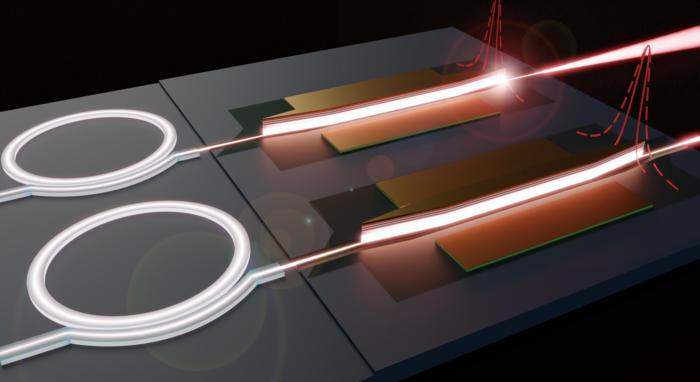On-chip laser diodes based on quantum well (QW) and quantum dot (QD) semiconductor materials have become the primary candidates for several applications due to their excellent characteristics, including high power efficiency, high-temperature operation, and small form-factors. Although QWs have been extensively used in commercial products, QDs have emerged as an attractive alternative due to their unique zero-dimensional density of states and atom-like degeneracy. Heterogeneous integration of III-V lasers with SiN microresonators, aided by self-injection locking, not only provides intrinsic advantages of compactness and high-volume production, but also enhances stability. This technology enables the realization of superior performance in terms of linewidth narrowing compared to that of III-V lasers grown on native platforms.

Credit: by Emad Alkhazraji, Weng W. Chow*, Frédéric Grillot, John E. Bowers, and Yating Wan
On-chip laser diodes based on quantum well (QW) and quantum dot (QD) semiconductor materials have become the primary candidates for several applications due to their excellent characteristics, including high power efficiency, high-temperature operation, and small form-factors. Although QWs have been extensively used in commercial products, QDs have emerged as an attractive alternative due to their unique zero-dimensional density of states and atom-like degeneracy. Heterogeneous integration of III-V lasers with SiN microresonators, aided by self-injection locking, not only provides intrinsic advantages of compactness and high-volume production, but also enhances stability. This technology enables the realization of superior performance in terms of linewidth narrowing compared to that of III-V lasers grown on native platforms.
A new study published in Light Science & Application conducted a parametric investigation of the design of active medium of composite cavity lasers. The team of researchers, led by Professor Yating Wan from the Integrated Photonics Lab at King Abdullah University of Science and Technology (KAUST), Saudi Arabia, Dr. Weng W. Chow from Sandia National Laboratories, Albuquerque, USA, Prof. Frédéric Grillot from LTCI, Télécom Paris, Institut Polytechnique de Paris, France, and Prof. John Bowers from the University of California Santa Barbara, USA, focused on the effects of carrier quantum confinement on the dynamic and spectral characteristics of the locked composite cavity device. Specifically, they examined the attainable emission spectral refinement, or linewidth narrowing, of integrating III-V QW or QD distributed feedback (DFB) lasers with SiN microring resonators. “When properly tuned and locked to one or more of the microring’s whispering gallery modes, optical feedback in the form of Rayleigh backscattering can enable drastic reductions in the lasing linewidth of a laser diode to the Hz-level.” Explained by Emad Alkhazraji, the first author of this research paper.
The parametric investigation was concluded with a multi-objective design-operation optimization analysis of both QW and QD devices via a genetic algorithm. A multi-decision algorithm was then employed to identify the optimal design-operation points for each optimization variable. “These findings provide guidance for more comprehensive parametric studies that can produce timely results for engineering design,” concluded Professor Yating Wan.
Journal
Light Science & Applications
DOI
10.1038/s41377-023-01172-9




